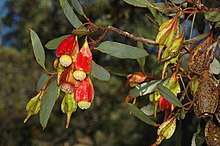Eucalyptus dolichorhyncha
Eucalyptus dolichorhyncha, commonly known as the fuchsia gum,[2] is a species of mallet that is endemic to the south-west of Western Australia. It has smooth, pale grey over pale brown bark, lance-shaped to oblong adult leaves, pendulous, solitary, red flower buds in leaf axils, yellow flowers and winged fruit that is square in cross-section.

| Fuschia gum | |
|---|---|
 | |
| Eucalyptus dolichorhyncha (cultivated specimen) | |
| Scientific classification | |
| Kingdom: | Plantae |
| Clade: | Tracheophytes |
| Clade: | Angiosperms |
| Clade: | Eudicots |
| Clade: | Rosids |
| Order: | Myrtales |
| Family: | Myrtaceae |
| Genus: | Eucalyptus |
| Species: | E. dolichorhyncha |
| Binomial name | |
| Eucalyptus dolichorhyncha | |
| Synonyms[1] | |
|
Eucalyptus forrestiana subsp. dolichorhyncha Brooker | |
Description
Eucalyptus dolichorhyncha is a mallet that typically grows to a height of 1–6 m (3 ft 3 in–19 ft 8 in) but does not form a lignotuber. It has smooth, pale grey over pale orange to pale brown bark. Young plants and coppice regrowth have leaves arranged alternately and egg-shaped to lance-shaped, 30–100 mm (1.2–3.9 in) long and 20–60 mm (0.79–2.36 in) wide and petiolate. Adult leaves are lance-shaped to oblong, 45–90 mm (1.8–3.5 in) long and 10–27 mm (0.39–1.06 in) wide on a petiole 8–16 mm (0.31–0.63 in) wide. The flower buds hang singly in leaf axils on a peduncle 20–42 mm (0.79–1.65 in) long, the pedicel 8–15 mm (0.31–0.59 in) long. Mature buds are red, oblong and square in cross section with a wing on each corner, 32–55 mm (1.3–2.2 in) long and 10–18 mm (0.39–0.71 in) wide. Flowering occurs between January and May and the flowers are yellow. The fruit is a woody capsule that is a similar shape to the mature buds, 29–40 mm (1.1–1.6 in) long and 13–30 mm (0.51–1.18 in) wide with the valves enclosed below the rim.[3][4]
Taxonomy and naming
Fuchsia gum was first formally described in 1973 by Ian Brooker who gave it the name Eucalyptus forrestiana subsp. dolichorhyncha and published the description in the Journal of the Royal Society of Western Australia. The type specimen was collected by John W. Green near Grass Patch in 1957.[5][6][7] In 1993, Brooker and Hopper raised the subspecies to species status as E. dolichorhyncha.[8] The specific epithet (dolichorhyncha) is derived from the Ancient Greek words dolichos meaning "long"[9]:494 and rhynchos meaning "snout" or "muzzle",[9]:561 referring to the long narrow operculum.[4]
Distribution and habitat
Eucalyptus dolichorhyncha has a limited range on flats in a small area along the south coast of the Goldfields-Esperance region of Western Australia north of Esperance where it grows in sandy clay or clay soils.[3]
Conservation status
This mallet is classified as "Priority Four" by the Government of Western Australia Department of Parks and Wildlife,[3] meaning that is rare or near threatened.[10]
See also
References
- "Eucalyptus dolichorhyncha". Australian Plant Census. Retrieved 24 June 2019.
- "Eucalyptus dolichorhyncha Fuschia Gum". Plant Selector. Government of South Australia. Retrieved 6 November 2018.
- "Eucalyptus dolichorhyncha". FloraBase. Western Australian Government Department of Parks and Wildlife.
- "Eucalyptus dolichorhyncha". Euclid: Centre for Australian National Biodiversity Research. Retrieved 4 June 2020.
- "Eucalyptus forrestiana subsp. dolichorhyncha". APNI. Retrieved 24 June 2019.
- Brooker, M. Ian H. (1973). "Eucalyptus forrestiana subsp. dolichorhyncha, a new taxon from Western Australia". Journal of the Royal Society of Western Australia. 56 (3): 74–75. Retrieved 24 June 2019.
- "Green, John W. (1930 - )". Council of Heads of Australasian Herbaria. Retrieved 24 June 2019.
- "Eucalyptus dolichorhyncha". APNI. Retrieved 24 June 2019.
- Brown, Roland Wilbur (1956). The Composition of Scientific Words. Washington, D.C.: Smithsonian Institution Press.
- "Conservation codes for Western Australian Flora and Fauna" (PDF). Government of Western Australia Department of Parks and Wildlife. Retrieved 24 June 2019.
